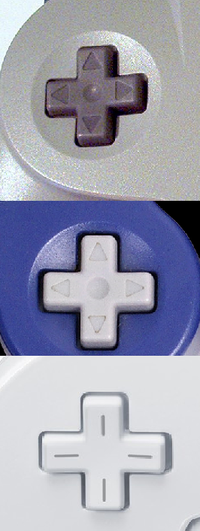Directional pad: Difference between revisions
No edit summary |
Aidanzapunk (talk | contribs) mNo edit summary |
||
| Line 3: | Line 3: | ||
[[File:DPad.png|thumb|The directional pad of the Nintendo 64 controller, the GameCube controller, and for both the Wii Remote and the Classic Controller.]] | [[File:DPad.png|thumb|The directional pad of the Nintendo 64 controller, the GameCube controller, and for both the Wii Remote and the Classic Controller.]] | ||
The '''directional pad''' (shortened '''d-pad''', officially '''+ Control Pad''') refers to the grey, cross-shaped group of buttons on the left side of the [[GameCube controller|GameCube]] and [[Nintendo 64 controller|Nintendo 64]] [[ | The '''directional pad''' (shortened '''d-pad''', officially '''+ Control Pad''') refers to the grey, cross-shaped group of buttons on the left side of the [[GameCube controller|GameCube]] and [[Nintendo 64 controller|Nintendo 64]] [[controller]]s, the varyingly-colored cross-shaped group of buttons located on the [[Wii Remote]], [[Classic Controller]], [[Nintendo 3DS]], [[Wii U GamePad]], and [[Wii U Pro Controller]], and grey, cross-shaped group of buttons on the left side of the [[Nintendo Switch Pro Controller]]. The [[Joy-Con]] have a group of four buttons in a diamond shape in the same place called the [[directional button|directional buttons]], with the same purpose. In ''[[Super Smash Bros.]]'', it serves no purpose other than menu navigation. In ''[[Super Smash Bros. Melee]]'', it continues to function as menu navigation, but also has a number of other uses. Pressing up during a fight will make the player's character [[taunt]]. The d-pad is also used for activating Fox and Falco's [[Smash Taunt|secret taunts]] and [[Samus's Extended Grapple]]. In [[Camera Mode]] and the Trophy Gallery, the d-pad can be used to move the camera. In ''[[Super Smash Bros. Brawl]]'', it takes the role of the [[control stick]] when played on a Wiimote, and reprises its role of taunts for any other controller. When using the Wii Remote with the [[Nunchuk]], pressing up will make the character [[jump]], while pressing sideways will make the character [[grab]] in specified direction, and pressing down will let the character [[shield]]. In {{for3ds}}, it once again takes the role of being used for the character's taunt, whereas in {{forwiiu}}, any controller reprises its role for taunts. In [[Ultimate]], the d-pad buttons are set to [[Taunts]] by default, but can be set to all other actions ([[Attack]], [[Special]], [[Jump]], [[Shield]] and [[Grab]]). | ||
When ''Super Smash Bros.'' is played on the [[Wii]] using a GameCube controller or Classic Controller, the d-pad is analogous to the N64 controller's [[L button]], used for the character's [[taunt]]. | When ''Super Smash Bros.'' is played on the [[Wii]] using a GameCube controller or Classic Controller, the d-pad is analogous to the N64 controller's [[L button]], used for the character's [[taunt]]. | ||
Revision as of 10:53, April 16, 2019
The directional pad (shortened d-pad, officially + Control Pad) refers to the grey, cross-shaped group of buttons on the left side of the GameCube and Nintendo 64 controllers, the varyingly-colored cross-shaped group of buttons located on the Wii Remote, Classic Controller, Nintendo 3DS, Wii U GamePad, and Wii U Pro Controller, and grey, cross-shaped group of buttons on the left side of the Nintendo Switch Pro Controller. The Joy-Con have a group of four buttons in a diamond shape in the same place called the directional buttons, with the same purpose. In Super Smash Bros., it serves no purpose other than menu navigation. In Super Smash Bros. Melee, it continues to function as menu navigation, but also has a number of other uses. Pressing up during a fight will make the player's character taunt. The d-pad is also used for activating Fox and Falco's secret taunts and Samus's Extended Grapple. In Camera Mode and the Trophy Gallery, the d-pad can be used to move the camera. In Super Smash Bros. Brawl, it takes the role of the control stick when played on a Wiimote, and reprises its role of taunts for any other controller. When using the Wii Remote with the Nunchuk, pressing up will make the character jump, while pressing sideways will make the character grab in specified direction, and pressing down will let the character shield. In Super Smash Bros. for Nintendo 3DS, it once again takes the role of being used for the character's taunt, whereas in Super Smash Bros. for Wii U, any controller reprises its role for taunts. In Ultimate, the d-pad buttons are set to Taunts by default, but can be set to all other actions (Attack, Special, Jump, Shield and Grab).
When Super Smash Bros. is played on the Wii using a GameCube controller or Classic Controller, the d-pad is analogous to the N64 controller's L button, used for the character's taunt.
In Melee, the directional pad also has uses not intended in regular gameplay: through the debug mode, it can be used to toggle the game mode, control Master Hand (also possible with the Name Entry glitch) and/or Crazy Hand, and spawn items in-game, among other things.[1]
References
| Controllers and buttons | |
|---|---|
| Nintendo 64 controller | |
| GameCube controller | |
| Wii Remote (and Nunchuk) | |
| Classic Controller | L |
| Nintendo 3DS | |
| Wii U GamePad / Pro Controller | L |
| Joy-Con | |
| Switch Pro Controller | L |
| Third-party controllers | Hori Mini Pad · Arcade controller · Keyboard |
| Other | Smash Controller · Controller modification |
